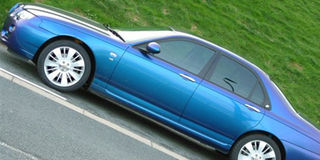Ask the mechanic : Why does my car lose power?

A car will lose power when going uphill if the engine has a fuel starvation problem. NET PHOTO
Hi Paul, I have a Corona Premio 1997 model. l have spent seven months since I bought it from a bond. Occasionally as I am driving uphill, it jerks and I try to accelerate but its power becomes less as if it’s running short of fuel.
Some times I drive smoothly without experiencing it. I have consulted some mechanics and they are saying my spark plugs need replacement together with plug wires. Is it true? If not, what could be the problem?
Thank you. Seba.
Hello Seba, if your mechanics have condemned your Toyota engine high tension leads and spark plugs because they are worn out, you ought to replace them. However, I think that your Toyota engine may have a fuel starvation issue.
That may explain the jerking when driving uphill. Your mechanic needs to investigate the fuel system. I suggest he starts by replacing the long life fuel filter. Should symptoms persist, escalate the search to include testing the fuel pump pressure using a fuel pressure testing kit.
Dear Paul,
What leads to shaking of the car when it’s in motion? I have taken it to my mechanic- who is good by the way, but it can stop for a while and then persists.
He tells me he changed the spark plugs (which I saw) but it will not stop shaking. At City Oil they told me wheel alignment, or balancing can help. I am very calculative of my next move since I am very new in the driving world. What can I do? Kindly respond
Hello, a car shaking, swaying or wobbling while in motion is a familiar experience for many drivers.
Another familiar situation is a car (engine) shaking while stationary, the two situations are often mixed up. When a vehicle shakes or vibrates while it is stationary, this is often a result of poor engine performance (due to interruption of spark, fuel or air supply) or worn out engine mountings.
Shaking , swaying or wobbling while in motion is usually caused by faulty suspension or steering components, damaged wheels or brakes.
Your car suspension is designed to dampen the dynamic stress and help maintain good road holding as you drive over uneven roads or fast around sharp bends.
Car suspension arms also help to attach the axle and wheel hub assemblies to the car body. When suspension components wear out, they cease to dampen dynamic road stress and your car will shake or sway.
Faulty steering systems or linkages are notorious for causing a swaying sensation. Damaged wheel rims and tyres will cause the wheel to wobble as you drive and the sensation increases with your car speed. Damaged brakes and brake rotors (discs) will also cause shaking and vibration.
Before you carry out wheel alignment, first ask an experienced mechanic to check your suspension, steering and wheels. Under take wheel alignment after the above repairs.
Hi Paul,
I have driven different automatic cars for four years but upto now I do not get clear responses on when to engage overdrive, turn it or off and at what speed.
Some say it should not completely show the red light. I got different views from two mechanics and two experienced government drivers also gave me different views.
For better use and better fuel maximisation, help me rest this case
Godfrey
Godfrey, the Overdrive (O/D) facility on your automatic gearbox works like the 5th gear on a manual gearbox. You switch on Over drive facility by pressing the O/D button on your gear stock shift. O/D is designed to reduce engine revolutions by selecting higher gear ratios.
This will improve fuel economy drastically. However, you should drive while alternating between O/D off and O/D on depending on the driving conditions.
For instance, driving in traffic jam, driving uphill or overtaking may require to switch O/D off and vice versa. Hope this helps ‘rest your case’.
Ask the mechanic
By Paul Kaganzi
0772316145
send sms: mycar (space) your comments and questions to 6933, or email them to [email protected]




